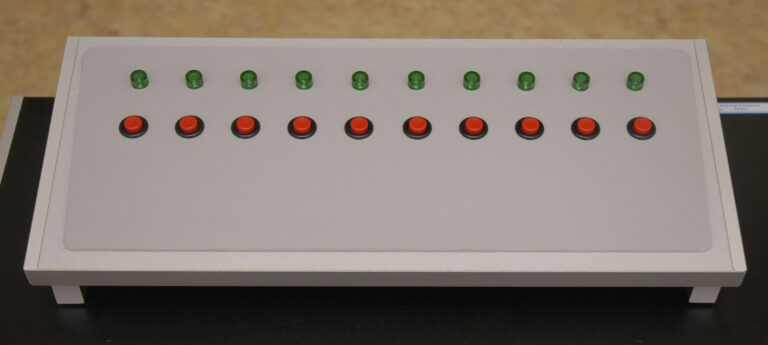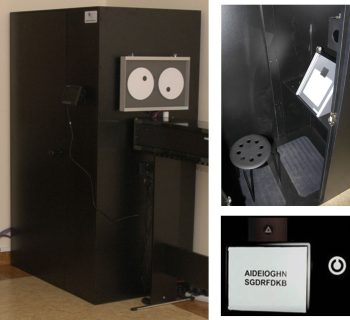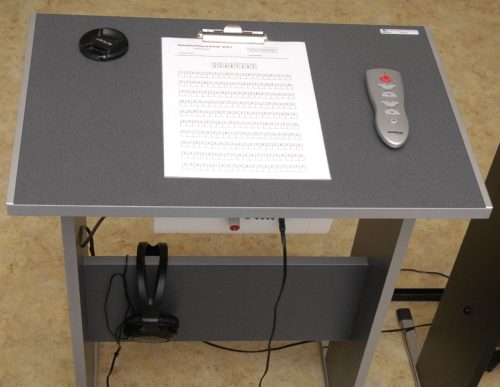Stationary test stand for psychological testing of drivers with components

Reaction time test stand
The test stand is used to measure the reaction time, i.e. the time needed to perform an external reaction in response to a stimulus. The measure of limb reaction parameters to light and sound stimuli, enables the measurement of reaction time and differentiates correct, wrong and delayed reactions.
The test stand consists of:
- control panel with a monitor and a set of buttons (a set of hand and foot buttons) – 220x140x50 mm,
- display part with a set of manipulators and a stimulus display column – 600x300x800 mm,
- transmission cable,
- power supply.
Eye-hand coordination measurement test stand
Eye-hand coordination takes place at the subconscious level, involving the visual and motor systems. It is based on the efficient and accurate transmission of impressions and observations to the executive locomotor system. The assessment covers both the speed and the accuracy of the respondent’s reaction both under stress, caused by time pressure, and under conditions of free pace of work, which in turn indicates the style of the respondent’s reaction.

- control panel with a monitor and a set of buttons – 190x135x50 mm,
- test keyboard – 300 x 300 x 50 mm, four rows of lights (two vertical, two horizontal) arranged 7 lights in each row, each row is situated on the different edge of the control panel, 49 buttons in 7 rows, 7 buttons each, buttons in the rows correspond to the arrangement of the lights in the vertical and horizontal row,
- transmission cable,
- power supply,
- table.

Test stand for measuring the decision-making time
A test stand for measuring the time of decision making and the precision of movements. The device allows you to determine the reaction time, including the average, minimum, maximum time and the level of efficiency expressed as a percentage.
The test stand consists of:
- control panel with a monitor and a set of buttons – 190x135x50 mm,
- test keyboard: 10 buttons for the examined person, 10 lamps – 435×110 mm,
- transmission cable,
- power supply,
- table.
Stereoscopic vision measurement test stand
- control panel with a monitor and a set of buttons – 215x140x50 mm,
- manipulator for the examined person – 190x140x45 mm,
- display device: apparatus /device with automatically controlled movable three identical bars (max diameter 10 mm, max height 300 mm, black color), maximum bar spacing 150 mm,
- tripod for the device,
- transmission cable,
- power supply.


Twilight vision and glare sensitivity measurement test stand
The test stand is used to assess: vision in the dark associated with distinguishing objects and shapes with minimal lighting and sensitivity to glare. The aim is to assess the perception abilities of the test person, necessary for driving a vehicle in night conditions. The device enables the determination of the lower threshold of visual sensitivity in conditions of limited light, glare sensitivity – its purpose is to determine the adaptation time (reconstruction) of the visual receptor after exposure to white light.
- control panel with liquid crystal display and set of buttons – 190x135x50 mm,
- display panel – 200x190x170 mm,
- illumination system,
- transmission cable,
- manual manipulator.
- control panel with a monitor – 215x140x50 mm,
- display panel – 300x350x25 mm,
- transmission cable,
- power supply,
- manipulator.

Work under stressful conditions simulator
Work under stressful conditions simulator is a device that tests the efficiency of cognitive functions: thinking, memory, attention, as well as the influence of auditory and visual distractors on the efficiency of cognitive functions. It allows you to determine the level of efficiency and the degree of concentration on the task under stress.
The device consists of:
- control panel with a set of buttons – 170x88x33 mm,
- display set with a remote control – 400x600x740 mm,
- headphones,
- test sheet,
- key of correct statements,
- transmission cable,
- power supply.
Standard system of psychophysiological diagnostics
- portable computer,
- control program,
- Recorder of the Psychophysiological State.


